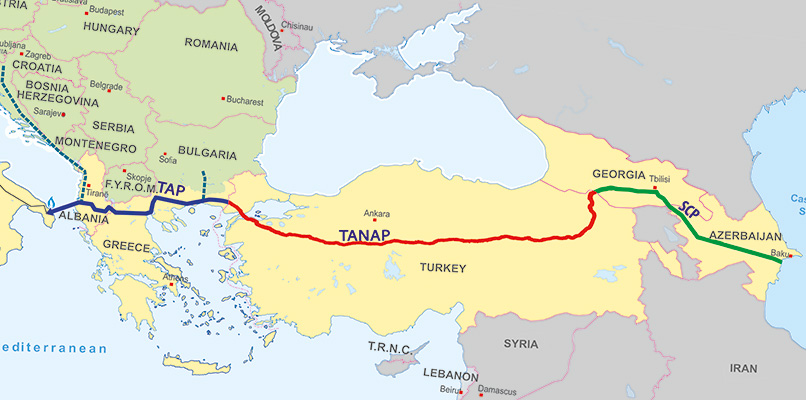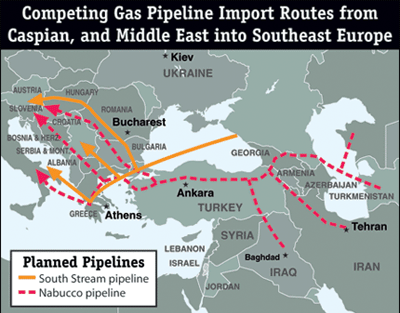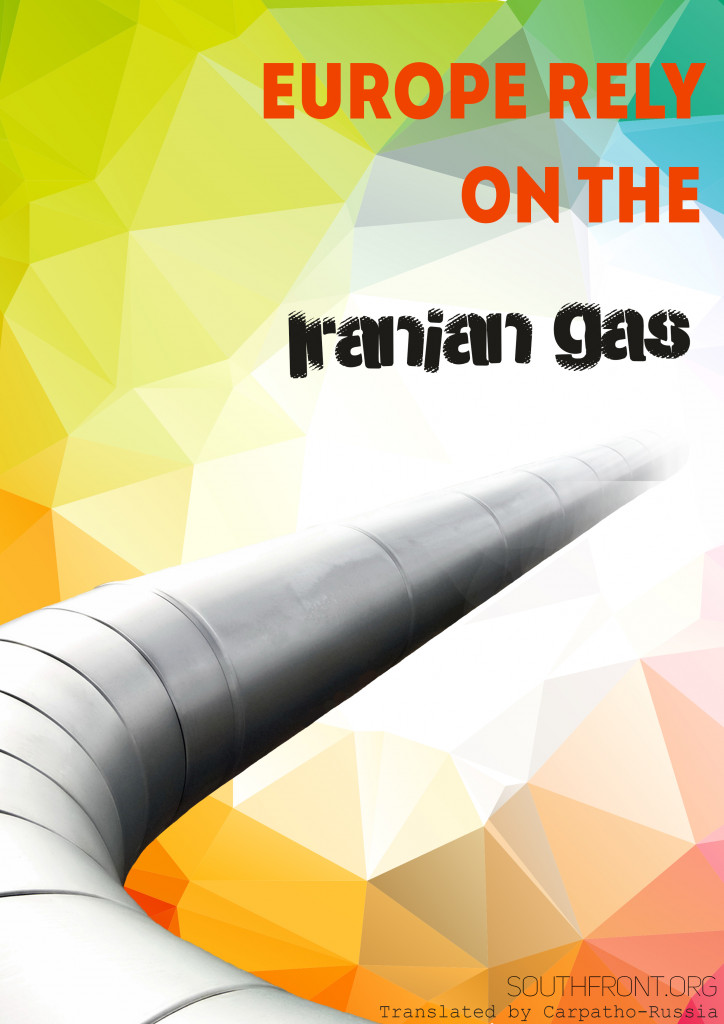The European bureaucracy is seeking to weaken the dependence on Russian resources by lifting the sanctions from Iran. But will it help in it?
This article originally appeared at Politrussia, translated from Russian by Carpatho-Russian exclusively for SouthFront
The European bureaucracy is a unique phenomenon in its own way. Neither the Russian State Duma, nor the Ukrainian Rada, nor the Israeli Knesset are able to compete as equals with their European colleagues in such nominations, as “Chief strategic miscalculation of the year” or “Most ridiculous design of the decade”.
Total degradation of the Institute for Strategic Planning, augmented by the surprising initiative of a number of politicians, today pose for Europe more of a major threat than implementation of phantom fears about “Russian aggression”.
The failed project to create a multicultural society, along with an absolutely idiotic migration policy and military intervention in internal get-togethers in the Middle East, have already turned into reality the forecasts of the author of the well-known novel “Mosque of the Parisian Mother of God”. But in the long list of evidences of chronic weak-mindedness and courage of European politicians, there stands by itself a project for energy security of Europe, which among the broad masses is constantly associated with the term that is popular now, “diversification of the gas supply”.
Chronic Russophobia, as we know, disconnects congenital instincts and immerses the victim of this illness in a parallel reality. In this reality, for example, Russian gas can be replaced by Azerbaijani, Turkmen, and Iranian. In this same reality, political dependence on deliveries of energy supplies from Russia is more dangerous than dependence on Turkey, which in this case is converted into the main transit hub between Europe and the countries of the Middle East and gains long-awaited tools for inducement of Europeans to numerous indecorous poses.
The “Caspian troika”
The dreams of the European bureaucrats to cut the share of Russian gas in the market are inseparably linked with the so-called “Caspian troika”. Besides Iran, this includes Azerbaijan and Turkmenistan. In one of the previous pieces we have already investigated in detail the actual, instead of media, possibilities of executing these two projects with participation of these countries – Nabucco and TANAP.
Let us permit ourselves to introduce two excerpts:
“The first stumbling block is the prime potentially possible supply source for the pipeline – Azerbaijan. In the country it is obvious that the necessary resources for supplying the Nabucco gas pipeline are missing, and in this regard the project was curtailed two years ago. Absolutely all volumes of gas to be extracted are contracted out for a long time, and the most recent prospecting work did not bring the expected results. The situation is comical in that now there is a question whether Azerbaijan can even ensure filling at least the TANAP gas pipeline with the promised 10 billion cubic meters by the date of delivery of the project, i.e. by 2019. Some experts affirm that Baku can only extract these volumes by 2021.
However if Azerbaijan succeeds after all in freeing up the desired 20 billion cubic meters, there is a question: where is the commercial sense in pulling Nabucco’s Bulgarian branch (1 billion cubic meters), if the TAP project in its design version is calculated for two parallel branches to Italy with total throughput capacity of 20 billion cubic meters. In addition, similar projects are intended for a specific pool of investors who are not present today, since the necessary capacities are absent.
In addition, there exist particular difficulties with implementing the TAP design. Not long ago, Azerbaijan won the tender for purchase of the Greek company DESFA, which owns the national gas transport system. But the hitch is that this directly contradicts the EU’s notorious Third Energy Package, as the gas producer has no right to own gas pipelines. Let us recall that in was specifically for this reason that South Stream construction had the brakes put on in every way possible. However, it is not the fact of interference with the transaction which is striking, but the response of the European Commission which is pulling the process forward from 2013, postponing decision-making two times. It is obvious that Azerbaijan has obtained a particular political weight in Europe, caused by false dreams of the European bureaucrats for replacing Russian gas».

Photo: TAP, TANAP and SCP gas pipelines
The second hindrance is dedicated to the possibilities of Turkmenistan outputting its gas on the European market:
“The second potential participant of the Nabucco project is Turkmenistan. But again: its participation in this project is improbable, since, despite the enormous volumes of the proven fields, almost all developed gas is contracted by China, Russia and Iran. In total this is nearly 80 billion cubic meters. The energy cooperation between Turkmenistan and China has broadened in recent years ever more actively: just in the last 6 years 3 branches of the Turkmenistan-China gas pipeline were put into service, which will permit driving absolutely all new volumes of gas to the East.
So Europe would have to fight for Turkmen “blue fuel” with China, trade with which is economically more attractive to Ashkhabad since Beijing is in a state to take up any volumes, and the gas pipeline is already constructed and functions quite successfully. In addition, there is a complication with a pipe interleaf at the bottom of the Caspian Sea since any of the country participants of the Caspian Union has the right to impose a veto on construction. Sometimes the appeal to environmental issues will play into our hands. In finishing the discussion on Turkmen gas, one must mention the project for the Trans-Afghan gas pipeline to Pakistan and India in which Turkmenistan plans to participate. In view of everything that has been enumerated, one may be sure that in the next decade Turkmenistan will be bound to the Asian markets in energy”.
It must also be noted that Turkmenistan stands today one step from catastrophe. Strong Islamist forces are concentrated along the Afghan-Turkmen border, and it is obvious that they are prepared to break in two directions. The first is from the Amu Darya valley, which in the most pessimistic version of the sequence of events will strike with an irreparable shock to the entire oil and gas industry of Turkmenistan. The second is from the Murghab valley, which again in the most unfavorable version of the sequence of events will mean capture of the largest resource foundation of the country – the Galkynysh fields. Thus, today not just the “European gas strategy of Turkmenistan”, but also the territorial integrity of the country are under a major question mark.
Persian fairy tales
The problem with the majority of network observers and some expert-analytical community is the blind belief in everything that Brussels or Washington say. The words of foreign politicians, surprisingly, are not exposed to doubt. However, as it was repeatedly demonstrated in practice, the overwhelming share of the information streams coming from Brussels is banal political demagogy, rather than something substantial, grounded on actual calculations and strategic estimates. The history with the exit of Iran from under sanctions is not an exception.
The main obstacle to the weighed and objective evaluation of the consequences of removing sanctions from Tehran is the propaganda cliché, extremely popular and absolutely inappropriate to reality, about the “complete economic isolation and blockade of Iran”. The efforts of politicians and journalists have created a stereotype that Tehran is cut off from all foreign markets, correspondingly, after the fall of the “Iron Sanctions Curtain” on Iran’s streams of hydrocarbons and other production of the national industry. A similar propaganda approach is actively in use now in Ukraine which, as we know, is “the last stronghold of Europe”, protecting it from a “horde of eastern barbarians” who are ready to just about ”pour into the West”.
However, the advertised picture about the complete isolation of Tehran does not correspond to reality. Joint designs of Iran with China, India, and South Korea are the clearest confirmation of that. For example, in 2009 China replaced the EU on the list as the main trading partner of Iran (annual turnover of 36 billion dollars).
One must also note that Tehran, developing within the concept of a restoration of the Persian empire, is spending enormous resources to reestablish its influence in the region. That is, the regional market is a priority for Iran.
But the main obstacle on the path of delivering Iranian “blue fuel” to Europe is a feature of the domestic gas market. For the most recent decades a serious problem of Iran’s economy is the swiftly increasing gas consumption within the country. So, in 1985 consumption was 8.2 billion cubic meters; in 2000, 62 billion; and in 2014, 174 billion. Parallel with the increase in consumption extraction also grew: in 1985, 9.2 billion cubic meters; in 2000, 59 billion; and in 2014, 174 billion.
The main consumer of extracted gas is private households which already use today on the order of 250 million cubic meters per day (from 150 million in the summer to 410 million in the winter). Using approximate calculations, annual consumption of just private households is estimated at 90-95 billion cubic meters. It is obvious that in the next few years the volumes will grow, since the program of gasification of the country is being implemented in practice at accelerated tempos. Thus, toward the end of 2015 gas should be provided to 90% of the population in 630 cities and 20% of the population in 4,300 village settlements. By 2016, 95% of the entire urban population and 80% of the entire rural one should be provided with gas.
The problem with increasing internal consumption is partly explained by wastage of Iranian private households. The managing director of the national gas corporation, Javad Ovdzhi, has already repeatedly addressed the population with an appeal to “use natural gas rationally” . According to his data, “average consumption of gas in the country is 18 times higher than in Japan, 9 times more on the average than in the countries of Europe, and 8 times that inhabitants of the United States”.
Significant volumes of extracted “blue fuel” are used by power plants which are currently transitioning from fluid fuel to natural gas – 34-41 billion cubic meters for all of 2014. The third large consumer is national industry, which used last year 32 billion cubic meters. Some of the extracted amounts (20-28 billion cubic meters) are coinjected into strata for maintenance of high efficiency during oil production.
Thus, even the total calculation of the minimum indexes of consumption of “blue fuel” for 2014 shows us that the domestic market consumes nearly all volumes of extracted gas – the annual production, as well as annual consumption, exactly evaluates to 174 billion cubic meters.
Requiem for a dream
The future of the Iranian gas sector today is under question, since in Tehran there exist two opposite strategies for development.
The first one is understood to mean development of export capacities, and the second, the development of the national oil-producing sector. Representatives of the “oil industry workers” camp alculated that in order to maintain high productivity of oil fields in strata, it is necessary to coinject approximately 120 billion cubic meters of gas, and by 2020 this number will approach 200 billion. To talk of increasing export capacities in the next decade will hardly be possible when executing this strategy. Supporters of the “export strategy” of developing the gas sector of Iran (National Iranian Gas Export Company) appeal to the fact that by 2020 the country can sell abroad about 80 billion cubic meters of gas.
It is must also be noted that, according to a forecast of experts from the Iranian National Gas Company, gas production by 2016 will reach 200 billion cubic meters, and by 2018 330 billion cubic meters. In some statements there are other numbers, the most widespread of which are 400 billion cubic meters by 2020 . Unfortunately, Iranian officials prefer in their forecasts for the future to be restricted to data on the possibilities of increasing gas production, but bypassing the aspect of increased consumption. At least, data is not present on predicted consumption of “blue fuel” inside the country for 2018 or 2020.
But even without turning to official forecasts, one may suppose with a high degree of confidence that the domestic market for natural gas consumption will continue to grow in Iran, and at enhanced rates. The basic consumer will continue to be private households, which should be completely gas-equipped by 2016-2017. Likewise, significant growth in consumption is expected from power plants, which within the next several years must reduce the share of “solid fuel” in production. The oil industry, independence of the adopted strategy (“export” or “oil”), will also draw off for itself large volumes of extracted gas.
Europeans should hardly count on deliveries of Iranian “blue fuel” even if Iran’s “gas dilemma” is resolved in favor of the supporters of an “export strategy”. As already mentioned, Tehran sees the future of the country solely in the status of a Persian empire, which is very problematic without binding its neighbors to its energy resources. Today, operations on bringing a gas pipeline into service to Iraq (10 billion cubic meters per year) are already coming to an end. Negotiations have been restarted with Pakistan on Mir [World] gas pipeline construction (12 billion cubic meters per year), which for Iran signifies the possibility of exporting to the voracious markets of India and China. Also, negotiations are being conducted on supplying gas to Oman, Kuwait, the United Arab Emirates, and Bahrain. The total capacity of these projects is estimated at 18-21 billion cubic meters. But separate material will be devoted to this subject.

Designs of possible gas pipelines to Europe.
Now we note that there is a more significant hindrance for Iranian gas pipeline routes to Europe. The overwhelming share of designs to transport this “blue fuel” on land routes pass through the territory of Turkey (earlier through Iraq and Syria). We wrote last week about what is happening in Erdogan’s ancestral lands, but in any case <a href = “http://politrussia.com/world/turtsiya-okazalas-mezhdu-337/”> we shall provide a brief excerpt: </a>
“The conclusion of a fragile truce between the Turkish government and the Kurdistan Workers’ Party was instantly reflected not only in the safety of the country, but also in the status of Turkey as the main transit route for hydrocarbons in the region. RPK fighters blasted two pipelines: the first one, the oil pipeline near Kirkuk through which approximately 11 million barrels a month arrived in the country, and the second, the gas pipeline in Agra province through which Iranian gas came to Turkey. It is most likely not necessary to say that serial explosions of pipelines will in the first place damage the reputation of the country, since the capability to ensure uninterrupted supply of hydrocarbons is priority for any investor”.
Only a consummate optimist could believe in a near-future truce between the Kurdistan Workers’ Party and the Turkish government . Thus, the territory of Turkey in the near future will be potentially dangerous for all exporters of hydrocarbons, since any conventional “competitor” now has the capability to organize the next diversion on the pipeline after providing worthy compensation, on top of everything else, to ideological fighters for independence from Turkey.
Thus, the special features of internal consumption, Tehran’s “gas strategy”, and a changeable regional environment threaten the European project to pressure Russia out of its gas market to remain a “pipedream”. At least for the next decade.






